Integrating Hourly Scale Hydrological Modeling and Remote Sensing Data for Flood Simulation and Hydrological Analysis in a Coastal Watershed
Abstract
:Featured Application
Abstract
1. Introduction
2. Study Sites and Materials
3. Methodology
4. Results
4.1. Parameter Sensitivity
4.1.1. Global Sensitivity
4.1.2. One-at-a-Time Sensitivity
4.2. Runoff Simulation
4.3. Hydrological Elements
5. Discussion
6. Conclusions
Author Contributions
Funding
Institutional Review Board Statement
Informed Consent Statement
Data Availability Statement
Conflicts of Interest
References
- Rudd, A.C.; Kay, A.L.; Sayers, P.B. Climate change impacts on flood peaks in Britain for a range of global mean surface temperature changes. J. Flood Risk Manag. 2023, 16, e12863. [Google Scholar] [CrossRef]
- Veijalainen, N.; Lotsari, E.; Alho, P.; Vehvilainen, B.; Kayhko, J. National scale assessment of climate change impacts on flooding in Finland. J. Hydrol. 2010, 391, 333–350. [Google Scholar] [CrossRef]
- Yang, G. Water issues in the Yangtze River and its formation causes and controlling strategies. Resour. Environ. Yangtze Basin 2012, 21, 821–830. [Google Scholar]
- Wu, J.; Chen, F.; Chen, X. Temporal and spatial features and correlation studies of global natural disasters from 1900 to 2018. Resour. Environ. Yangtze Basin 2021, 30, 976–991. [Google Scholar]
- Neitsch, S.L.; Arnold, J.G.; Kiniry, J.R. Soil and Water Assessment Tool User’s Manual; Version 2000; GSWRL Report 02-02; Grassland, Soil & Water Research Laboratory: Temple, TX, USA, 2002. [Google Scholar]
- Arnold, J.G.; Srinivasan, R.; Muttiah, R.S.; Williams, J.R. Large area hydrologic modeling and assessment—Part I: Model development. J. Am. Water Resour. Assoc. 1998, 34, 73–89. [Google Scholar] [CrossRef]
- Kannan, N.; Santhi, C.; Williams, J.R.; Arnold, J.G. Development of a continuous soil moisture accounting procedure for curve number methodology and its behaviour with different evapotranspiration methods. Hydrol. Process. 2008, 22, 2114–2121. [Google Scholar] [CrossRef]
- Abbaspour, K.C.; Rouholahnejad, E.; Vaghefi, S.; Srinivasan, R.; Yang, H.; Klove, B. A continental-scale hydrology and water quality model for Europe: Calibration and uncertainty of a high-resolution large-scale SWAT model. J. Hydrol. 2015, 524, 733–752. [Google Scholar] [CrossRef]
- Sinnathamby, S.; Douglas-Mankin, K.R.; Craige, C. Field-scale calibration of crop-yield parameters in the Soil and Water Assessment Tool (SWAT). Agric. Water Manag. 2017, 180, 61–69. [Google Scholar] [CrossRef]
- Mekonnen, B.A.; Mazurek, K.A.; Putz, G. Modeling of nutrient export and effects of management practices in a cold-climate prairie watershed: Assiniboine River watershed, Canada. Agric. Water Manag. 2017, 180, 235–251. [Google Scholar] [CrossRef]
- Zhang, X.Y.; Liu, X.M.; Luo, Y.Z.; Zhang, M.H. Evaluation of water quality in an agricultural watershed as affected by almond pest management practices. Water Res. 2008, 42, 3685–3696. [Google Scholar] [CrossRef] [PubMed]
- Brighenti, T.M.; Bonuma, N.B.; Srinivasan, R.; Chaffe, P.L.B. Simulating sub-daily hydrological process with SWAT: A review. Hydrol. Sci. J. 2019, 64, 1415–1423. [Google Scholar] [CrossRef]
- Singh, V.; Bankar, N.; Salunkhe, S.S.; Bera, A.K.; Sharma, J.R. Hydrological stream flow modeling on Tungabhadra catchment: Parameterization and uncertainty analysis using SWAT CUP. Curr. Sci. 2013, 104, 1187–1199. [Google Scholar]
- Meng, X.; Wang, H.; Lei, X.; Cai, S.; Wu, H.; Ji, X.; Wang, J. Hydrological modeling in the Manas River Basin using soil and water assessment tool driven by CMADS. Teh. Vjesn.-Tech. Gaz. 2017, 24, 525–534. [Google Scholar] [CrossRef]
- Meng, X.; Wang, H. Significance of the China Meteorological Assimilation Driving Datasets for the SWAT model (CMADS) of East Asia. Water 2017, 9, 765. [Google Scholar] [CrossRef]
- Bauwe, A.; Tiedemann, S.; Kahle, P.; Lennartz, B. Does the temporal resolution of precipitation input influence the simulated hydrological components employing the SWAT model? J. Am. Water Resour. Assoc. 2017, 53, 997–1007. [Google Scholar] [CrossRef]
- Campbell, A.; Pradhanang, S.M.; Anbaran, S.K.; Sargent, J.; Palmer, Z.; Audette, M. Assessing the impact of urbanization on flood risk and severity for the Pawtuxet Watershed, Rhode Island. Lake Reserv. Manag. 2018, 34, 74–87. [Google Scholar] [CrossRef]
- Jeong, J.; Kannan, N.; Arnold, J.; Glick, R.; Gosselink, L.; Srinivasan, R. Development and integration of sub-hourly rainfall-runoff modeling capability within a watershed model. Water Resour. Manag. 2010, 24, 4505–4527. [Google Scholar] [CrossRef]
- Yang, X.; Liu, Q.; He, Y.; Luo, X.; Zhang, X. Comparison of daily and sub-daily SWAT models for daily streamflow simulation in the Upper Huai River Basin of China. Stoch. Environ. Res. Risk Assess. 2016, 30, 959–972. [Google Scholar] [CrossRef]
- Shannak, S. Calibration and validation of SWAT for sub-hourly time steps using SWAT-CUP. Int. J. Sustain. Water Environ. Syst. 2017, 9, 21–27. [Google Scholar]
- Boithias, L.; Sauvage, S.; Lenica, A.; Roux, H.; Abbaspour, K.C.; Larnier, K.; Dartus, D.; Sanchez-Perez, J.M. Simulating flash floods at hourly time-step using the SWAT model. Water 2017, 9, 929. [Google Scholar] [CrossRef]
- Chaubey, I.; Cotter, A.S.; Costello, T.A.; Soerens, T.S. Effect of DEM data resolution on SWAT output uncertainty. Hydrol. Process. 2005, 19, 621–628. [Google Scholar] [CrossRef]
- Moriasi, D.N.; Arnold, J.G.; Van Liew, M.W.; Bingner, R.L.; Harmel, R.D.; Veith, T.L. Model evaluation guidelines for systematic quantification of accuracy in watershed simulations. Trans. ASABE 2007, 50, 885–900. [Google Scholar] [CrossRef]
- Singh, J.; Knapp, H.V.; Arnold, J.G.; Demissie, M. Hydrological modeling of the iroquois river watershed using HSPF and SWAT. J. Am. Water Resour. Assoc. 2005, 41, 343–360. [Google Scholar] [CrossRef]
- Wellen, C.; Kamran-Disfani, A.R.; Arhonditsis, G.B. Evaluation of the current state of distributed watershed nutrient water quality modeling. Environ. Sci. Technol. 2015, 49, 3278–3290. [Google Scholar] [CrossRef] [PubMed]
- Jeong, J.; Kannan, N.; Arnold, J.G.; Glick, R.; Gosselink, L.; Srinivasan, R.; Harmel, R.D. Development of sub-daily erosion and sediment transport algorithms for SWAT. Trans. ASABE 2011, 54, 1685–1691. [Google Scholar] [CrossRef]
- Cho, J.; Lowrance, R.R.; Bosch, D.D.; Strickland, T.C.; Her, Y.; Vellidis, G. Effect of subdivision on SWAT flow, sediment, and nutrient predictions. J. Am. Water Resour. Assos. 2004, 40, 811–825. [Google Scholar] [CrossRef]
- Abbaspour, K.C.; Vaghefi, S.A.; Srinivasan, R.A. Guideline for Successful Calibration and Uncertainty Analysis for Soil and Water Assessment: A Review of Papers from the 2016 International SWAT Conference. Water 2018, 10, 6. [Google Scholar] [CrossRef]
- Student. The Probable Error of a Mean. Biometrika 1908, 6, 1–25. [Google Scholar] [CrossRef]
- Fu, C.S.; James, A.L.; Yao, H.X. SWAT-CS: Revision and testing of SWAT for Canadian Shield catchments. J. Hydrol. 2014, 511, 719–735. [Google Scholar] [CrossRef]
- Fu, C.S.; Lee, X.; Griffis, T.J.; Baker, J.M.; Turner, P.A. A Modeling Study of Direct and Indirect N2O Emissions From a Representative Catchment in the US Corn Belt. Water Resour. Res. 2018, 54, 3632–3653. [Google Scholar] [CrossRef]
- Morris, M.D. Factorial sampling plans for preliminary computational experiments. Technometrics 1991, 33, 161–174. [Google Scholar] [CrossRef]
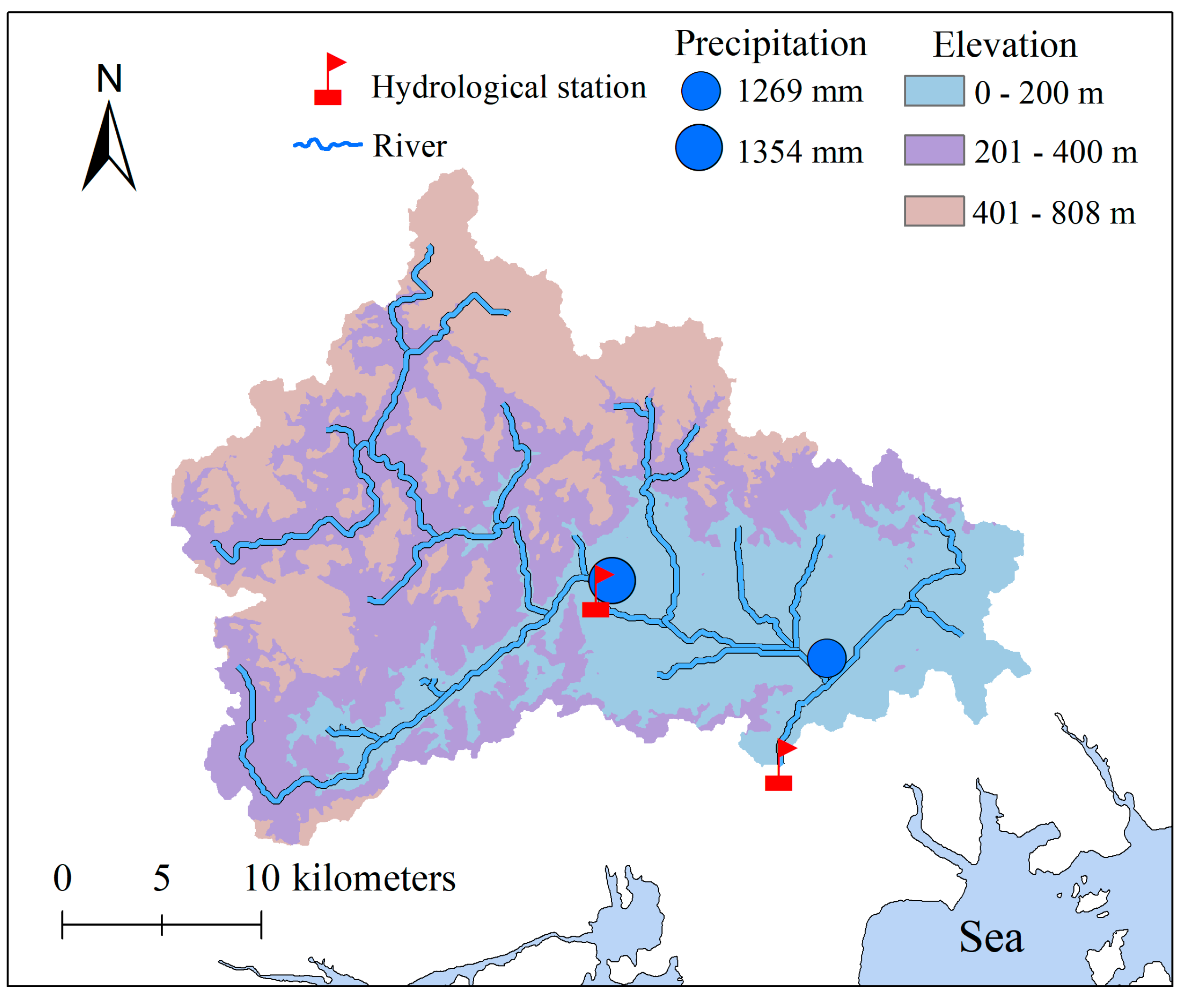


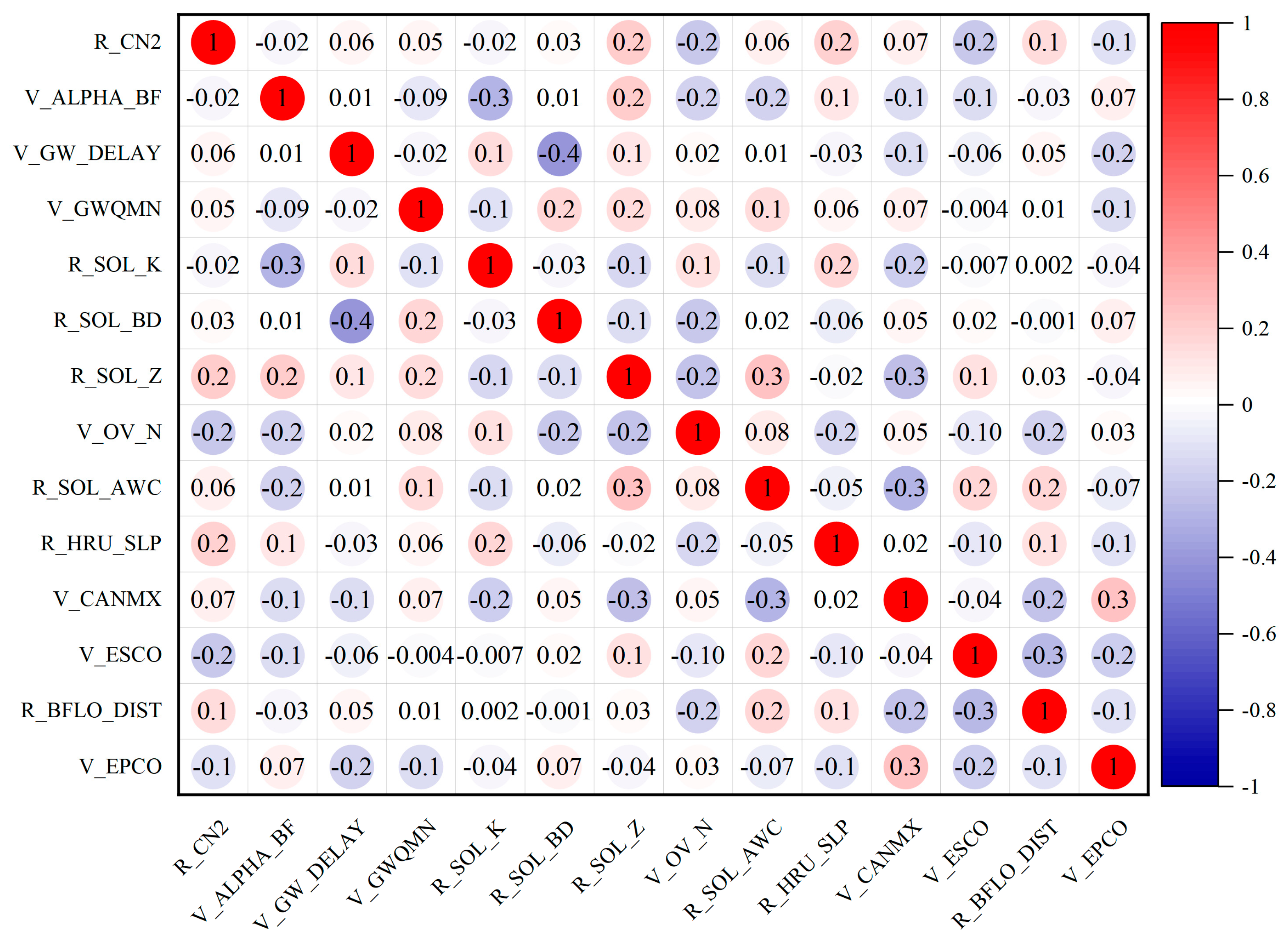
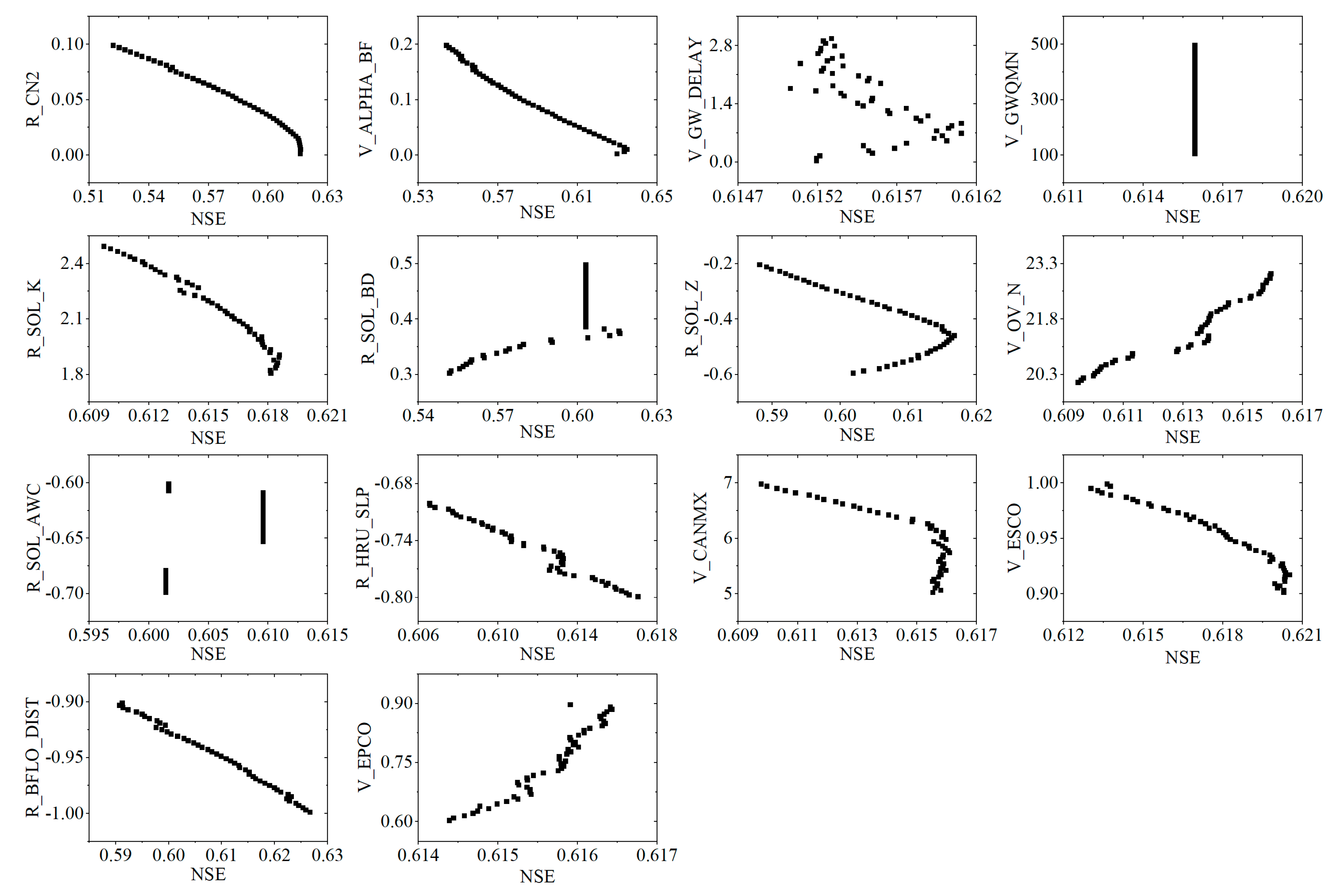
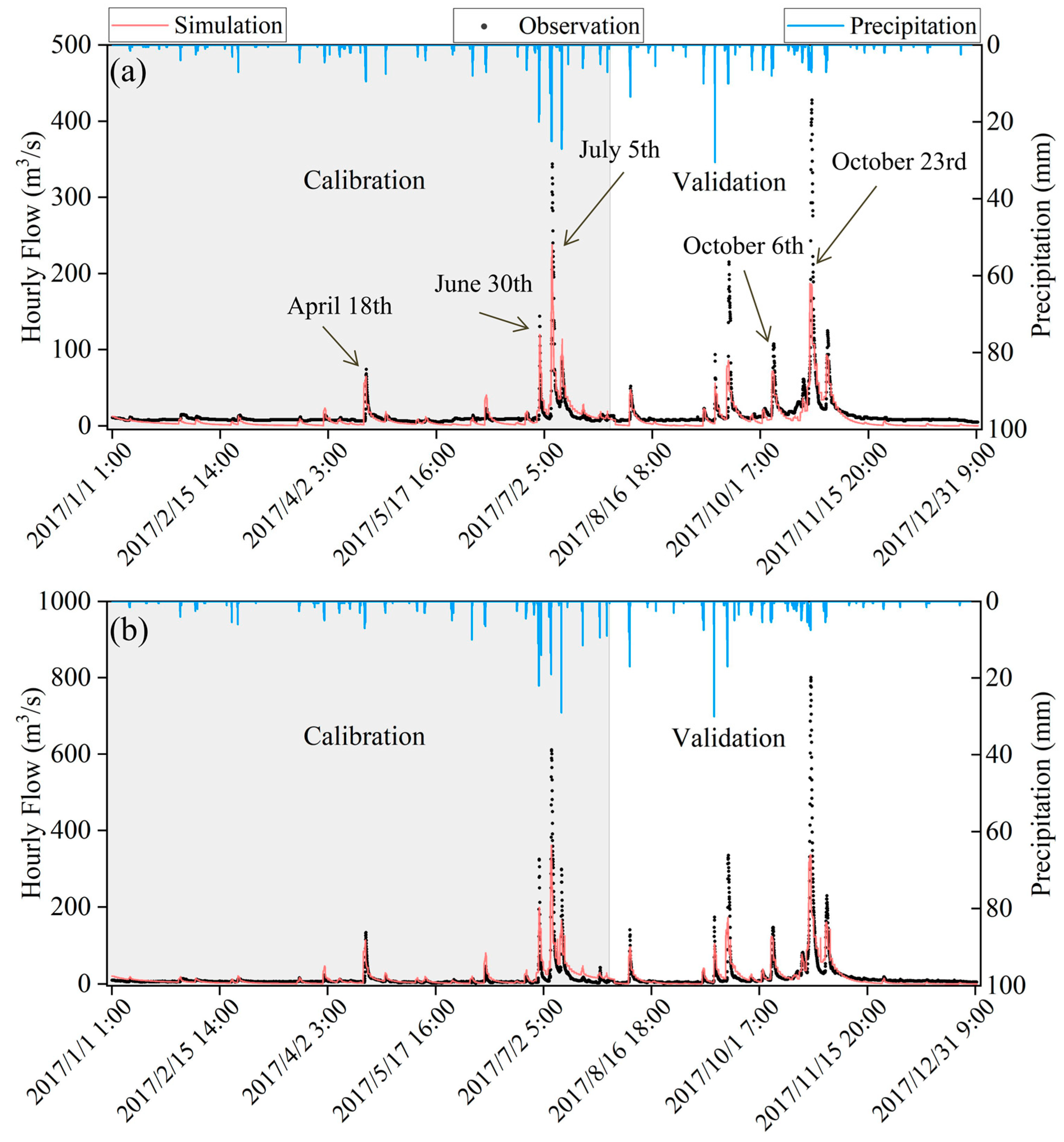
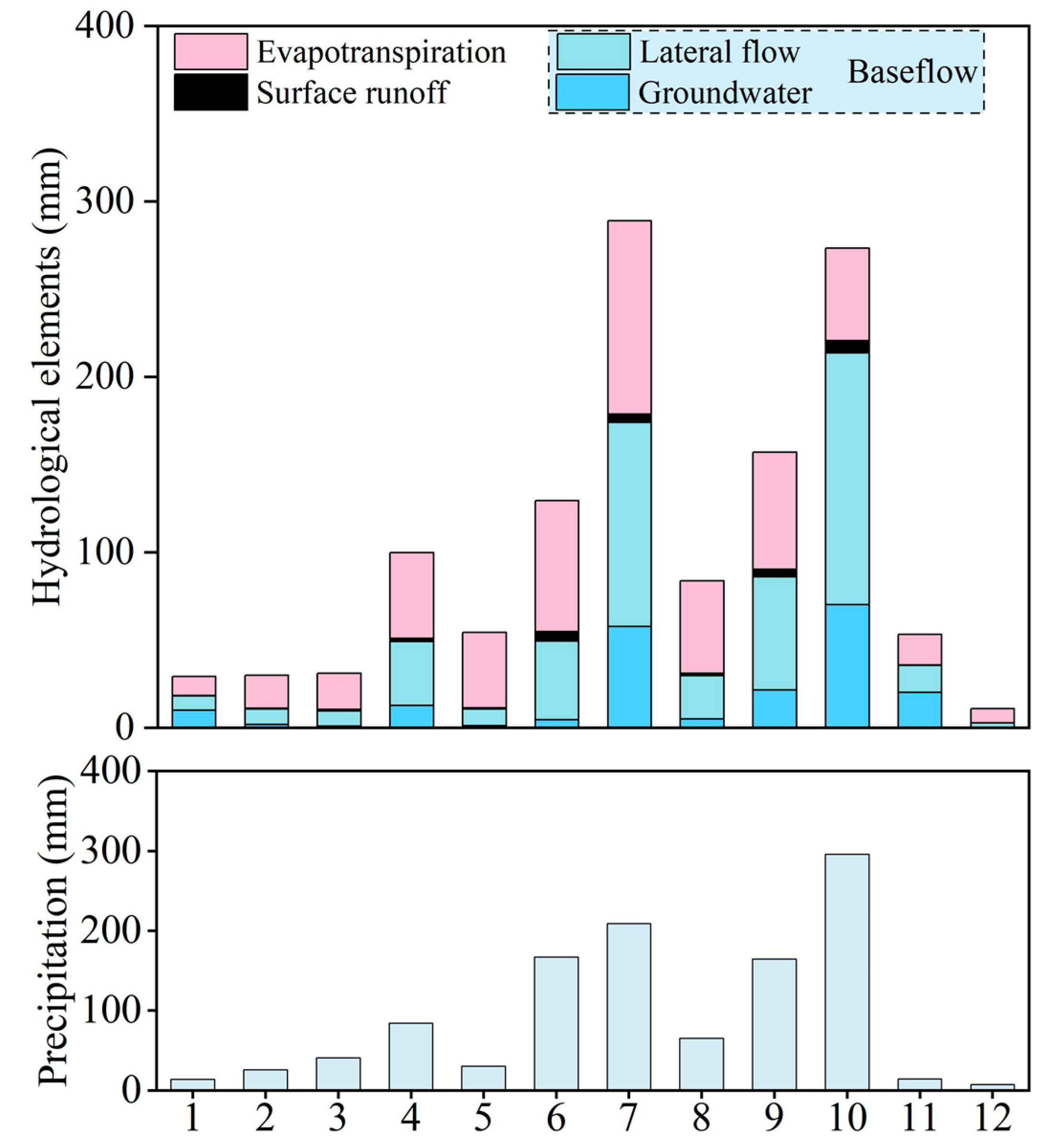

| Data Type | Source URL | Resolution/Scale/Number of Sites |
|---|---|---|
| DEM | https://earthexplorer.usgs.gov (19 July 2019) | 30 m |
| Soil | https://nlftp.mlit.go.jp (29 July 2019) | 1:1,000,000 |
| Land use | https://nlftp.mlit.go.jp (29 July 2019) | 1:25,000 |
| Weather | http://www.data.jma.go.jp (30 July 2019) | 2 |
| Hourly river flow | http://www.river.go.jp (5 August 2019) | 2 |
| ID | Parameter Name | Description | T-Stat | p-Value | Fitted Value | Min Value | Max Value |
|---|---|---|---|---|---|---|---|
| 1 | SOL_BD | Moist bulk density (Mg/cm3) | 5.66 | 0.00 | 0.37 | 0.30 | 0.50 |
| 2 | ALPHA_BF * | Baseflow alpha factor (days) | −4.11 | 0.00 | 0.04 | 0.00 | 0.20 |
| 3 | BFLO_DIST | Baseflow distribution factor for sub-daily simulation (fraction) | −3.53 | 0.00 | −0.97 | −1.00 | −0.90 |
| 4 | CN2 | SCS runoff curve number (dimensionless) | −3.00 | 0.00 | 0.01 | 0.00 | 0.10 |
| 5 | ESCO * | Soil evaporation compensation factor (fraction) | −1.37 | 0.18 | 0.98 | 0.90 | 1.00 |
| 6 | SOL_AWC | Available water capacity of the soil layer (fraction) | 1.19 | 0.24 | −0.66 | −0.70 | −0.60 |
| 7 | GWQMN * | Threshold depth of water in the shallow aquifer required for return flow to occur (mm) | 1.07 | 0.29 | 304.00 | 100.00 | 500.00 |
| 8 | OV_N * | Manning’s “n” value for overland flow (dimensionless) | 1.00 | 0.32 | 23.0 | 20.00 | 23.00 |
| 9 | EPCO * | Plant uptake compensation factor (fraction) | 0.70 | 0.49 | 0.80 | 0.60 | 0.90 |
| 10 | CANMX * | Maximum canopy storage (mm) | −0.70 | 0.49 | 5.82 | 5.00 | 7.00 |
| 11 | HRU_SLP | Average slope steepness (m/m) | −0.37 | 0.72 | −0.80 | −0.80 | −0.70 |
| 12 | SOL_Z | Depth from soil surface to bottom of layer (mm) | 0.36 | 0.72 | −0.48 | −0.60 | −0.20 |
| 13 | SOL_K | Saturated hydraulic conductivity (mm/hr) | −0.14 | 0.89 | 2.13 | 1.80 | 2.50 |
| 14 | GW_DELAY * | Groundwater delay (days) | 0.10 | 0.92 | 0.75 | 0.00 | 3.00 |
| Index | Fuzhong Station | Shanshou Station | ||
|---|---|---|---|---|
| Calibration | Validation | Calibration | Validation | |
| R2 | 0.64 | 0.61 | 0.65 | 0.56 |
| NSE | 0.61 | 0.59 | 0.64 | 0.57 |
| Elements | T-Statistic | p-Value |
|---|---|---|
| Surface runoff | 3.25 | <0.05 |
| Lateral flow contribution to streamflow | 3.03 | <0.05 |
| Groundwater contribution to streamflow | 2.55 | <0.05 |
| Baseflow | 2.91 | <0.05 |
| Evapotranspiration | 4.95 | <0.05 |
| Air temperature | 6.19 | <0.05 |
Disclaimer/Publisher’s Note: The statements, opinions and data contained in all publications are solely those of the individual author(s) and contributor(s) and not of MDPI and/or the editor(s). MDPI and/or the editor(s) disclaim responsibility for any injury to people or property resulting from any ideas, methods, instructions or products referred to in the content. |
© 2023 by the authors. Licensee MDPI, Basel, Switzerland. This article is an open access article distributed under the terms and conditions of the Creative Commons Attribution (CC BY) license (https://creativecommons.org/licenses/by/4.0/).
Share and Cite
Cao, Y.; Fu, C.; Yang, M. Integrating Hourly Scale Hydrological Modeling and Remote Sensing Data for Flood Simulation and Hydrological Analysis in a Coastal Watershed. Appl. Sci. 2023, 13, 10409. https://doi.org/10.3390/app131810409
Cao Y, Fu C, Yang M. Integrating Hourly Scale Hydrological Modeling and Remote Sensing Data for Flood Simulation and Hydrological Analysis in a Coastal Watershed. Applied Sciences. 2023; 13(18):10409. https://doi.org/10.3390/app131810409
Chicago/Turabian StyleCao, Yang, Congsheng Fu, and Mingxiang Yang. 2023. "Integrating Hourly Scale Hydrological Modeling and Remote Sensing Data for Flood Simulation and Hydrological Analysis in a Coastal Watershed" Applied Sciences 13, no. 18: 10409. https://doi.org/10.3390/app131810409
APA StyleCao, Y., Fu, C., & Yang, M. (2023). Integrating Hourly Scale Hydrological Modeling and Remote Sensing Data for Flood Simulation and Hydrological Analysis in a Coastal Watershed. Applied Sciences, 13(18), 10409. https://doi.org/10.3390/app131810409






